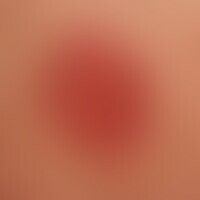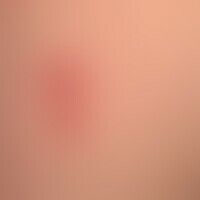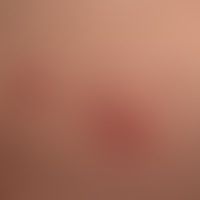Fixed drug eruption Images
Go to article Fixed drug eruption
Drug reaction, fixed: two red, sharply defined, moderately itchy plaques that have existed for a few days. The peripheral areas are lighter in colour, with a tendency to blistering in the centre. Irregular use of headache medication known and added (!).

Drug reaction, fixed (detail). two red, sharply defined, moderately itchy plaques, existing for a few days. the peripheral areas are lighter in colour, tendency to blistering in the centre. irregular intake of headache medication known and admitted.

Drug reaction, fixed (detail): Two red, sharply defined, moderately itchy plaques which have existed for a few days. The peripheral areas are lighter in colour, with indicated blistering in the centre (circle). Irregular use of headache medication known and added.





Drug reaction, fixed: multilocular fixed drug reaction with extensive epidermolysis on sharply defined erosions in the area of the back of the hand and thumb.

Drug reaction fixe: multilocular FA with incipient epidermolysis on sharply defined plaques on the back of the hand and fingers.

Drug reaction, fixed: recurrent course with acute itchy redness 1 day after taking ibuprofen (600 mg) due to rheumatoid complaints. After 2-3 days the acute symptoms subsided with the residual hyperpigmentation shown here. The acute changes occurred strictly localized.

Drug reaction, fixed: suddenly appeared, reddish-brownish, roundish, sharply defined, hardly infiltrated plaques, existing for a few days. 20-year-old female patient. Probably drug-induced cause: paracetamol.

Drug reaction, fixed: suddenly appeared, for 3 days existing, erythematous, isolated, roundish, sharply defined plaques with central blisters of about 4-5 cm diameter on the abdomen of a 20-year-old female patient; probably the skin changes are due to the intake of paracetamol.

drug reaction fixe: red plaques, existing for several days, moderately sharply defined, little itchy. the peripheral areas are slightly leaking. tendency to blistering. DD: erysipelas (fever?, painful lymphadenitis?, leucocytosis?)

Drug reaction fixed: red, sharply defined, little itchy plaques that have been present for several days; tendency to central blistering.





Drug reaction, fixed: acute, solitary, red, sharply defined, moderately itchy plaque which has been present for 2 days. The peripheral areas are lighter in colour, blistering in the centre. 62-year-old patient. Irregular intake of headache medication.

Drug reaction, fixed: acute, solitary, initially deep red painful erythema; after a few days extensive detachment of the skin on the scrotum.


Drug reaction, fixed: solitary or limited to a few lesions, usually round to oval, deep red, later blue to brown-red, after healing brownish, sharply defined, succulent, itchy or slightly painful erythema.

Drug reaction, fixed. multilocular FA (1st recurrence in loco) after administration of ibuprofen, 24 h before the first symptoms appear. The present spots are older than 1 week. ring and indicated cocardium structures (see right side of the thigh, initial central bladder).




Drug reaction, fixed: unusual image of a 3.5 x 2.5 cm measuring, crusty covered, flat ulcer on the lower leg of a 38-year-old patient as a result of repeated use of non-steroidal anti-inflammatory drugs; the reddish discolored periulcerous area and the blue-violet discoloration of the necroses result from the topical application of methylrosanilinium chloride during external therapy.



